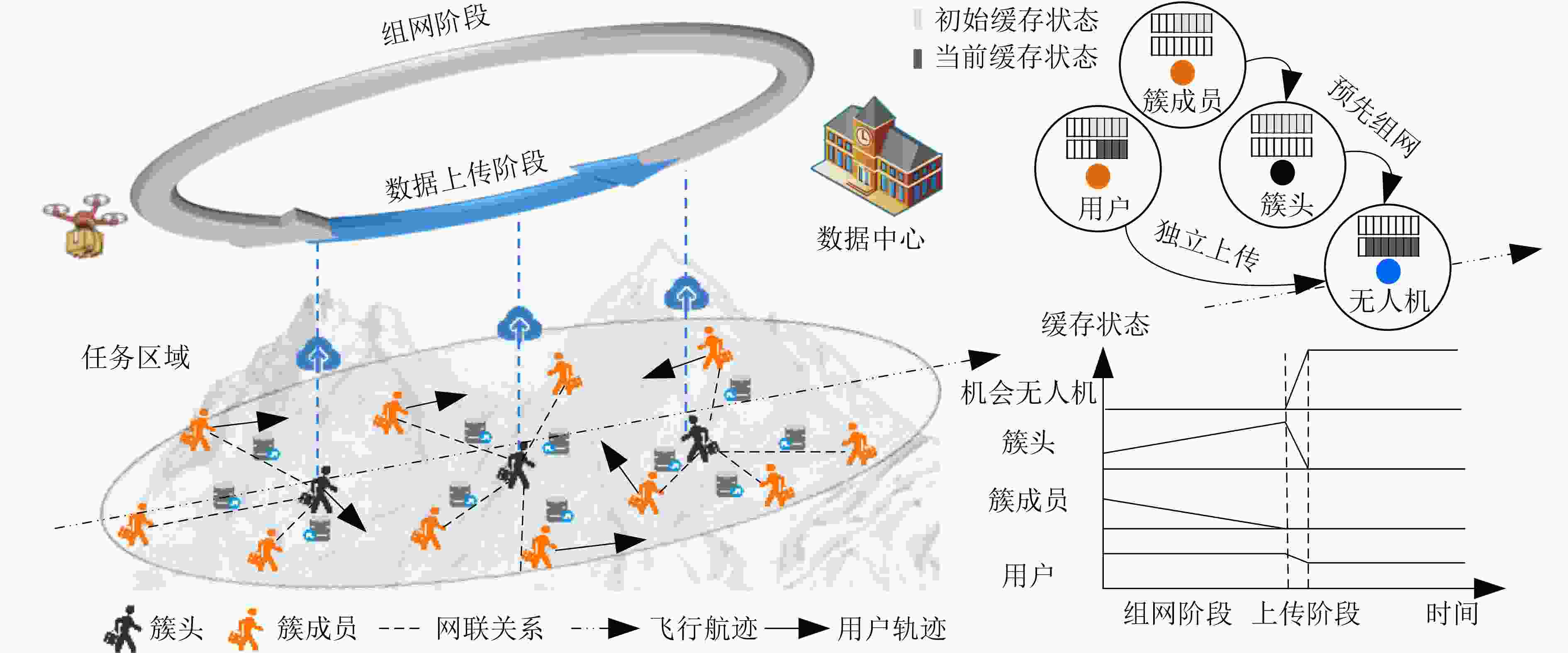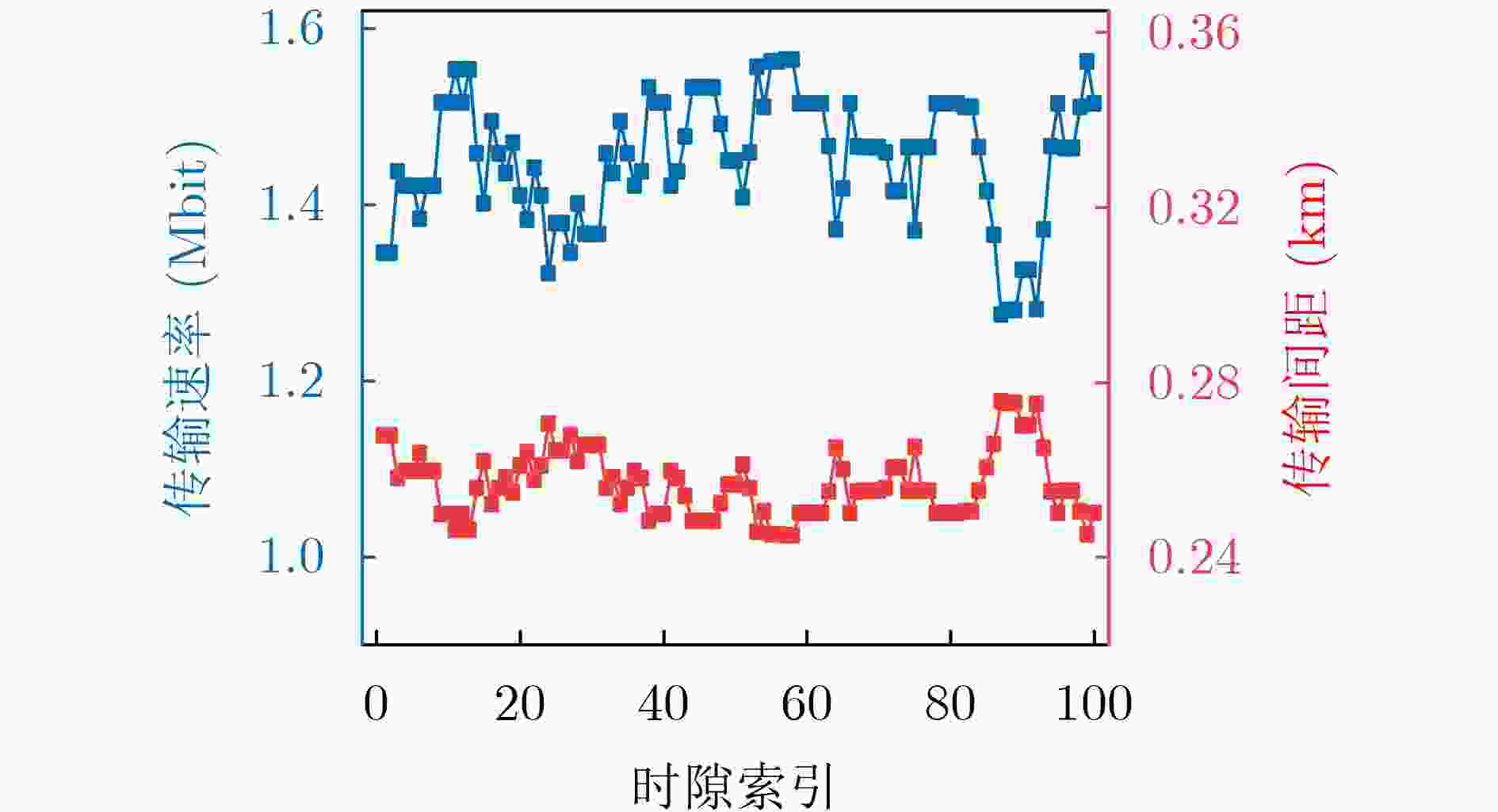Networking and Resource Allocation Methods for Opportunistic UAV-assisted Data Collection
-
摘要: 配备存储部件的机会无人机打开了数据传输的机会时间窗口,在低空数据收集系统中呈现巨大的潜力。为了提高数据收集效率,移动用户可以主动组网,将数据预先集聚到具备位置优势的簇头节点,由簇头节点负责上传,实现时空维度的流量塑形。该文研究了机会无人机辅助数据收集的组网和资源分配方法。具体而言,如何根据机会无人机的既定航迹,通过联合优化用户的子网数据传输策略、子网资源分配策略和子网形成策略,最大化全网数据上传总量。上述问题高度耦合且具有海量的状态空间,较难求解。该文通过推导闭式表达式求解子网数据传输和资源分配子问题,通过联盟博弈求解子网形成子问题。最终提出了一种迭代优化算法来获得具有高效、可靠、自组织和低复杂度的解决方案。仿真结果表明所提方法能够有效提升数据收集效率。同独立上传策略以及基于距离聚类和传统联盟博弈组网策略相比,所提方案的数据上传总量分别提升了56.3%,51.6%和17.8%。Abstract:
Objective Unmanned Aerial Vehicles (UAVs) tasked with customized operations, such as environmental monitoring and intelligent logistics, are referred to as opportunistic UAVs. These UAVs, while traversing the task area, can be leveraged by ground nodes in regions that are either uncovered or heavily loaded, enabling them to function as data storage. This reduces the operational costs associated with deploying dedicated UAVs for data collection. In practice, however, the flight paths of opportunistic UAVs are uncontrolled, and the data-uploading capabilities of ground nodes in various regions vary. To enhance efficiency, ground nodes can actively form a network, pre-aggregate data, and allocate resources to cluster head nodes located advantageously for data transmission. Despite extensive research into networking technologies, two key challenges remain. First, existing studies predominantly focus on static networking strategies, overlooking the reliability of data aggregation in mobile scenarios. Ground nodes involved in tasks such as emergency response, disaster relief, or military reconnaissance may exhibit mobility. The dynamic topology of these mobile nodes, coupled with non-line-of-sight transmission path loss and severe signal fading, creates substantial challenges for reliable transmission, leading to bit errors, packet losses, and retransmissions. Therefore, mobile ground nodes must dynamically adjust their subnet data transmission strategies based on the time-varying relative distances between cluster members and heads. Second, most studies focus on data aggregation capacity within subnets but fail to consider the uploading capabilities of cluster heads. In opportunistic communication scenarios, where UAV flight paths are uncontrolled, the data-uploading capacity of each subnet is constrained by the minimum of the data collected, aggregation capacity, and uploading capability. Therefore, effective networking strategies for opportunistic UAV-assisted data collection must account for the relationships between cluster members, cluster heads, and UAVs. Coordinated resource allocation and subnet formation strategies are essential to improving system performance. In summary, exploring networking and resource allocation methods for opportunistic UAV-assisted data collection is of significant practical importance. Methods Due to the interdependent nature of the subnet data transmission, resource allocation, and formation strategies, the problem presents a large state space that is difficult to solve directly. To address this, a decomposition approach is applied. First, given the subnet formation strategy, the paper sequentially derives the closed-form solutions for the subnet data transmission and resource allocation strategies, significantly simplifying the original problem. Next, the subnet formation subproblem is modeled as a formation game. An altruistic networking criterion is proposed, and using potential game theory, it is proven that the formulated game has at least one pure strategy Nash equilibrium. A subnet formation strategy based on the best response method is proposed. Finally, the convergence and complexity of the proposed algorithm are analyzed. Results and Discussions Simulation results confirm the effectiveness of the proposed algorithm. As shown in the networking diagram, the algorithm predominantly selects nodes near the flight path as cluster heads due to their superior data uploading capabilities ( Fig. 2 ,Fig. 3 (a)). The data uploaded is constrained by the minimum values of the data collected, data aggregation capacity, and data uploading capacity, creating a bottleneck. In this context, the algorithm balances subnet data aggregation and uploading capacities, ultimately improving transmission efficiency (Fig. 3 (b)). Additionally, the relationship between distance and subnet data transmission strategy is evaluated. Specifically, the proposed transmission strategy reduces the amount of data aggregated for reliability as the distance increases, while increasing data aggregation for efficiency when the distance decreases (Fig. 4 ). This dynamic transmission approach enhances reliability as the amount of aggregated data fluctuates (Fig. 5 (a)). Furthermore, the proposed algorithm outperforms benchmark networking schemes with increasing iteration numbers, demonstrating up to a 56.3% improvement (Fig. 5 (b)). Finally, regardless of variations in flight speed, the proposed algorithm consistently shows superior transmission efficiency (Fig. 5 (c)).Conclusions This paper explores terrestrial networking and resource allocation methods to enhance the transmission efficiency of opportunistic UAV-assisted data collection. The strategies for subnet data transmission, resource allocation, and formation are jointly addressed. The paper derives closed-form solutions for the subnet data transmission and resource allocation strategies sequentially, followed by the formulation of the subnet formation strategy as a formation game, which is solved using the best response method. Extensive simulation results validate the performance improvements. However, this study considers only scenarios with a single opportunistic UAV. In practical applications, multiple UAVs may coexist, requiring further analysis of the time-varying relationships between cluster heads and UAVs in future work. -
1 机会无人机辅助的组网和资源分配算法
输入:用户的数据量${\varGamma _i}$,用户移动轨迹$l_i^t$,无人机航迹$l_m^t$,基
本参数$ {\mathcal{T}^{\rm g}},{\mathcal{T}^{\mathrm{u}}},{d_{{\mathrm{th}}}},{B_0} $输出:子网数据传输策略${\boldsymbol{Q}}$,子网资源分配策略${\boldsymbol{B}}$和子网形成
策略${\bf{Co}}$(1) 初始化组网分组,每个节点自成一个联盟 (2) FOR $ t = 1:{T_{{\mathrm{iter}}}} $ (3) $i = \text{mod} (t,U) + 1$ (4) 用户${u_i}$离开当前联盟${\text{C}}{{\text{o}}_n}$探索加入联盟${{\mathrm{Co}}_{n'}}$ (5) 簇头$u_0^n$和$u_0^{n'}$根据$ \bar Q_{i,n}^*({\Pr ^{{\text{req}}}}) $、$ \bar Q_{i,n'}^*({\Pr ^{{\text{req}}}}) $和式(26)更
新子网资源分配策略(6) 用户${u_i}$根据式(20)更新数据传输策略 (7) If 联盟切换满足互利准则式(33)do (8) 联盟结构变更,$ {{\mathrm{Co}}_n} = {{\mathrm{Co}}_n}\backslash \{ {u_i}\} ,{{\mathrm{Co}}_{n'}} = {{\mathrm{Co}}_{n'}} \cup \{ {u_i}\} $ (9) End If (10) End For -
[1] 吴启晖, 董超, 贾子晔, 等. 低空智联网组网与控制理论方法[J]. 航空学报, 2024, 45(3): 28809. doi: 10.7527/S1000-6893.2023.28809.WU Qihui, DONG Chao, JIA Ziye, et al. Networking and control mechanism for low-altitude intelligent networks[J]. Acta Aeronautica et Astronautica Sinica, 2024, 45(3): 28809. doi: 10.7527/S1000-6893.2023.28809. [2] LIU Dianxiong, XU Yuhua, WANG Jinlong, et al. Opportunistic UAV utilization in wireless networks: Motivations, applications, and challenges[J]. IEEE Communications Magazine, 2020, 58(5): 62–68. doi: 10.1109/MCOM.001.1900687. [3] HARDES T and SOMMER C. Opportunistic airborne virtual network infrastructure for urban wireless networks[J]. Computer Communications, 2023, 208: 220–230. doi: 10.1016/j.comcom.2023.06.003. [4] ZHONG Xijian, GUO Yan, LI Ning, et al. Joint relay assignment and channel allocation for opportunistic UAVs-aided dynamic networks: A mood-driven approach[J]. IEEE Transactions on Vehicular Technology, 2020, 69(12): 15019–15034. doi: 10.1109/TVT.2020.3032125. [5] LIU Yitong, YAN Junjie, and ZHAO Xiaohui. Deep-reinforcement-learning-based optimal transmission policies for opportunistic UAV-aided wireless sensor network[J]. IEEE Internet of Things Journal, 2022, 9(15): 13823–13836. doi: 10.1109/JIOT.2022.3142269. [6] LI Bowen and CHEN Junting. Large timescale optimization for communications over aerial ad hoc networks with predetermined trajectories[J]. IEEE Transactions on Communications, 2024, 72(10): 6371–6385. doi: 10.1109/TCOMM.2024.3393980. [7] SUN Zhuo, WEI Zhiqiang, YANG Nan, et al. Two-tier communication for UAV-enabled massive IoT systems: Performance analysis and joint design of trajectory and resource allocation[J]. IEEE Journal on Selected Areas in Communications, 2021, 39(4): 1132–1146. doi: 10.1109/JSAC.2020.3018855. [8] KANG M and JEON S W. Energy-efficient data aggregation and collection for multi-UAV-enabled IoT networks[J]. IEEE Wireless Communications Letters, 2024, 13(4): 1004–1008. doi: 10.1109/LWC.2024.3355934. [9] CHAI Rong, GAO Yifan, SUN Ruijin, et al. Time-oriented joint clustering and UAV trajectory planning in UAV-assisted WSNs: Leveraging parallel transmission and variable velocity scheme[J]. IEEE Transactions on Intelligent Transportation Systems, 2023, 24(11): 12092–12106. doi: 10.1109/TITS.2023.3299842. [10] GHDIRI O, JAAFAR W, ALFATTANI S, et al. Offline and online UAV-enabled data collection in time-constrained IoT networks[J]. IEEE Transactions on Green Communications and Networking, 2021, 5(4): 1918–1933. doi: 10.1109/TGCN.2021.3104801. [11] LIN Xin, LIU Aijun, NI Wanli, et al. Sum rate maximization of ad-hoc network in adversarial communication environments: A game-theoretic approach[J]. IEEE Transactions on Vehicular Technology, 2024, 73(11): 17905–17910. doi: 10.1109/TVT.2024.3416129. [12] QIN Zhen, WEI Zhenhua, QU Yuben, et al. AoI-aware scheduling for air-ground collaborative mobile edge computing[J]. IEEE Transactions on Wireless Communications, 2023, 22(5): 2989–3005. doi: 10.1109/TWC.2022.3215795. [13] ZHOU Jianshan, TIAN Daxin, WANG Yunpeng, et al. Reliability-optimal cooperative communication and computing in connected vehicle systems[J]. IEEE Transactions on Mobile Computing, 2020, 19(5): 1216–1232. doi: 10.1109/TMC.2019.2907491. [14] 韩晨, 刘爱军, 安康, 等. 干扰环境下基于博弈论的无人机群部署与组网方法[J]. 电子与信息学报, 2022, 44(3): 860–870. doi: 10.11999/JEIT210992.HAN Chen, LIU Aijun, AN Kang, et al. Deployment and networking methods of UAV swarm in jamming environments based on game theory[J]. Journal of Electronics & Information Technology, 2022, 44(3): 860–870. doi: 10.11999/JEIT210992. [15] MOZAFFARI M, SAAD W, BENNIS M, et al. Wireless communication using unmanned aerial vehicles (UAVs): Optimal transport theory for hover time optimization[J]. IEEE Transactions on Wireless Communications, 2017, 16(12): 8052–8066. doi: 10.1109/TWC.2017.2756644. [16] SANDHOLM T, LARSON K, ANDERSSON M, et al. Coalition structure generation with worst case guarantees[J]. Artificial Intelligence, 1999, 111(1/2): 209–238. doi: 10.1016/S0004-3702(99)00036-3. -






 下载:
下载:






 下载:
下载:
